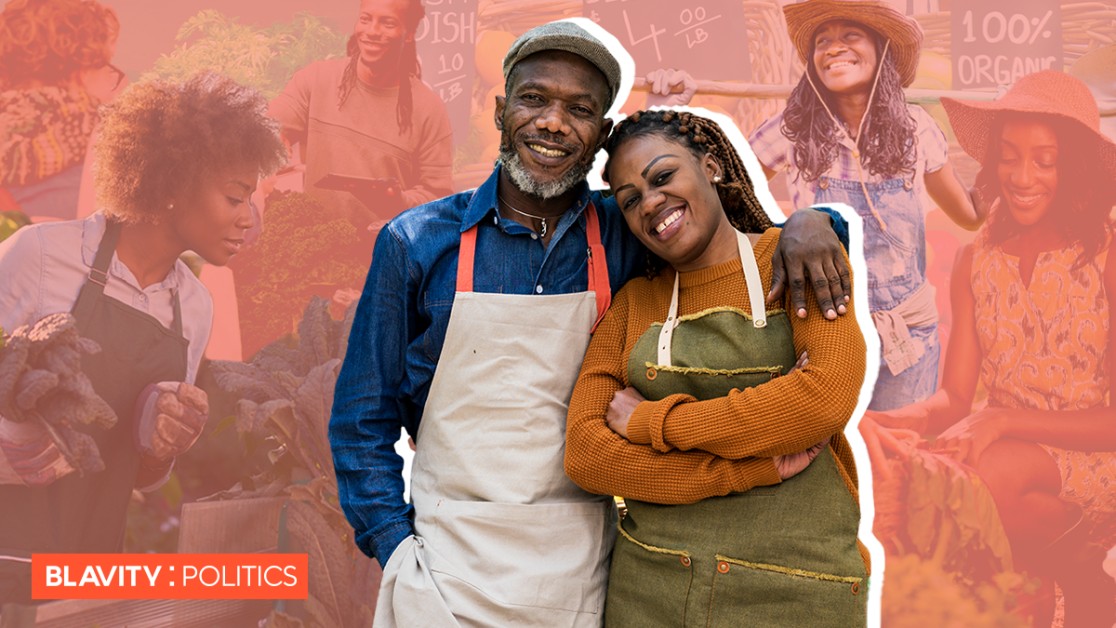Since 1998, the East New York Farmers’ Market has provided fresh produce, safe public spaces and wholesome activities for the residents of East New York, Brooklyn. This farmers’ market is in bright contrast to the pervasive food desert that extends throughout the predominantly Black neighborhood. For the last two decades, gardeners and volunteers in the East New York Farms (ENYF) network have strived to engage their community thoughtfully in food production and consumption matters.
Marlene Wilks, one of the local gardeners, told Blavity that “the goal is to provide healthy eating for the people in the area.” This is a necessary and admirable goal, as adults in East New York, Brooklyn’s Fifth Community District rank 48th among 59 districts in the likelihood that they’ll consume at least one serving of fruit or vegetables per day.
Wilks and gardeners from 42 participating gardens grow and sell fresh produce at the market.
The East New York Farmers' Market operates on Saturdays, adjacent to the United Community Centers (UCC) Youth Farm, and on Wednesdays, at the Hands and Heart Community Garden. ENYF sells a plethora of local and tropical fruits and vegetables, ranging from common fare, like pumpkin, squash, kale and tomatoes, to unexpected international crops, like callaloo, Scotch bonnet peppers and cerasee. All are available to members of the community (35% of whom are foreign-born).
The size and variety of this harvest is the result of member and volunteer gardening labor. Some of the gardens within the ENYF project have as many as 28 member gardeners who clean planting beds, plant crops and harvest the season’s growth for the market. In order to produce such an assortment of fruits and vegetables, some of the gardeners tend to the gardens and urban farms nearly all year long. Wilks told Blavity that vegetables, like lettuce, might need to be planted in the early fall, while certain Caribbean melon crops might require April plantings.
All of this work leads to bountiful harvests that keep the semi-weekly market stocked and well-patronized. Wilks revealed that for popular items, like callaloo, “[the market] can have 50 bundles in the morning and sell out by 10 a.m.” She further explained that selling out like this is ideal to ensure that everything the gardeners grow is sold.
Despite having an engaged and supportive consumer community, the farmers’ market and the gardeners aren’t focusing on profits.
“The amount we work is not about the money,” Wilks said. “It’s really about serving people. It’s a community service.”
This belief in community service has benefited both the shoppers and gardeners. Shoppers at the market find reasonably-priced, fresh produce, a consequence of the low-fee gardening memberships. Gardeners who are members at any of the community gardens in the East New York Farms project only pay $25 annual dues and $7 per every planting bed they use. If the planting bed is cleaned and maintained throughout the season and all crops are harvested, each gardener is refunded $5 per planting bed they till. The gardeners also receive some money from product sales. The low cost of enrollment creates an inexpensive opportunity, even for residents in more trying financial situations, to be physically active, while also dismantling their neighborhood’s food desert.
Gardening, as a community improvement activity, has generally been beneficial for East New York residents, but its positives have been particularly noticeable for young people.
Anita Chan, ENYF’s Agricultural Programs Coordinator, told Blavity that preteens and teenagers prep and plant-soil like their older counterparts. At the UCC Youth Farm, young people grow and harvest from March through November (roughly the operating season for the farmers’ market). When school is out, however, the kids and teenagers often work four days a week, completing a considerable amount of work for ENYF. The hard work these young gardeners invest and the agricultural skills they gain have had dramatic effects on their lives.
“We did a survey a few years ago, and 95% of kids who sell in the market and work in the garden go to college,” Wilks said. “[Working here] also changed their eating habits.”
Information from the New York City Department of Health and Human Hygiene actually show the relation between Wilks’ observations. According to the department, “higher education levels are associated with better health outcomes.” East New York’s college graduation rate is 22% lower than the New York City average, but the UCC Youth Farm is helping young minds remedy their neighborhood's achievement gap by successfully preparing them for college matriculation.
The ENYF is doing both physically and mentally transformative work for East New York, but climate change is starting to impede the work ENYF does for its community. Increasing carbon emissions and hotter growing seasons have had a noticeable effect on ENYF’s crop yield this year.
“This is the hardest growing year I’ve seen,” Wilks lamented. Her frustration comes from an increased occurrence of invasive weeds in the gardens this year. Crops need carbon dioxide to grow and thrive but so do weeds. As carbon emissions steadily increase, they create an environment that supports an abundance of weeds. Unfortunately, this has made the gardeners' growing work more burdensome.
Additionally, the historically hot days this year have created inhospitable conditions for certain crops.
“Last year, we had about 18 pumpkins, and this year, we have three little ones,” Wilks told Blavity. She also found that the oppressive heat has been decreasing the market’s supply of eggplants, one of their more popular items.
Climate change may pose a challenge to the gardeners, but their work shows no signs of slowing. Just within the next two weeks, ENYF is hosting workshops on using plants as dyes, preparing honey bees for the winter, and seed keeping — all of this is in addition to their regularly scheduled farmers’ markets. The work that ENYF does illustrates how Black communities throughout the country act collectively to improve their personal and environmental well-being, despite looming institutional obstacles.
